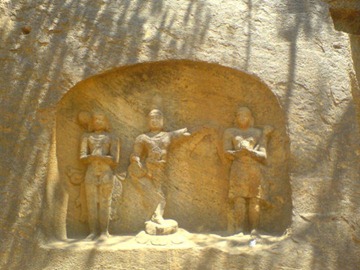Rock cut cave temples provide deep insight into the construction technique of the yore. Some of them formed naturally while some were created.
 The ‘Kudavarai koil’ or rock cut cave temple is one of the earliest work of art that brings to light the architectural skills of people of a different era. It is a treasure trove of information.
The ‘Kudavarai koil’ or rock cut cave temple is one of the earliest work of art that brings to light the architectural skills of people of a different era. It is a treasure trove of information.
Rock-cut architecture flourished during Pallava rule (7th century A.D.) and most of their work is seen at Mahabalipuram. Similar architecture from the same time is also found in and around Madurai.
According to art historian K.T. Gandhirajan, there are two types of rock cut architecture found – the ones drilled from the front and monolithic stone carved from top to bottom.
“They explain how people chiselled rocks in natural caves to cater to their living needs like polishing the floors, creating stone beds and steps, a channel and tank to direct and collect the rainwater.
Some ‘kudavarais’ also belong to earlier periods (between c 200 B.C. to c 400 A.D.), which we come to know through the Brahmi scripts,” he informs.
Some of the Tamil Brahmi script found in the cave temples date back to ancient period with mention about how people altered the place with help of stone masons.
Those in Mangulam, Arittapatti, Thiruvathavur, Keezhavalavu, Kongar Puliankulam, Varichiyur, Vikkramangalam, Mettupatti, Karungalakudi, Mudhalaikulam, Alagar Malai, Tirupparankundram, Muthupatti, Yanaimalai and Kunnakudi, talk about artisans and people who sponsored the work.
“Tamil Brahmi script is located in 36 places in the State and most of the clusters are found in and around Madurai with references to people’s knowledge of construction techniques during Sangam Age.
 The city has so many of them as in those times it was the epicentre for learning Tamil language and literature. Poets from various places arrived here to exhibit their talent before the king and some stayed in stone shelters,” notes Mr. Gandhirajan.
The city has so many of them as in those times it was the epicentre for learning Tamil language and literature. Poets from various places arrived here to exhibit their talent before the king and some stayed in stone shelters,” notes Mr. Gandhirajan.
Pallava and Pandia Kings encouraged art and architecture and structural architecture gained popularity. People were more aware of the growing construction techniques. There were more trained artisans whose understanding of comfort stay and rain water collection is amazing.
Around 50 cave temples including Tirupparankundram, Yanaimalai, Pillaiyarpatti and Kazhugumalai were constructed between 7th and 8th century A.D. during Pandia period. But many of them were left incomplete.
“There might be umpteen reasons for this like political disturbances. Gradually, cave temples gave way to construction of temples inside the city. Rocks were cut to size and transported. Though many cave temples are incomplete, they highlight good aesthetic sense,” he says.
Cave architecture saw ornamentation with advent of Jains during the 8th and 9th century A.D. who showed their might with bas relief structures and constructed several rock-cut beds and carved figurines on the walls. It can be seen in Yanaimalai, Muthupatti and Arittapatti cave temples.
Author: T. Saravanan | Source: The Hindu [January 05, 2011]